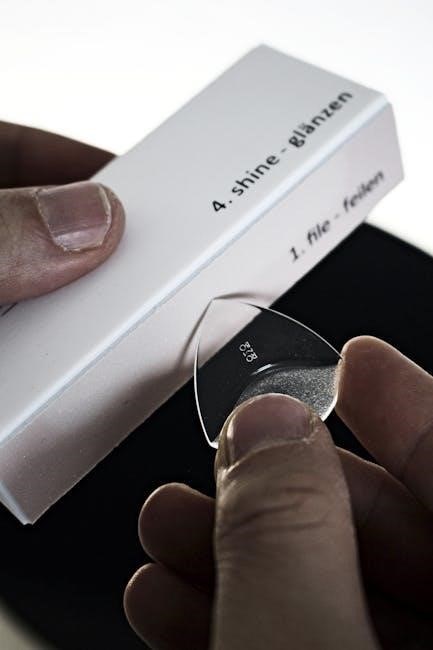ls lansky sharpeners instructions
Lansky Sharpeners are renowned for their controlled-angle sharpening systems, ensuring precise blade sharpening. Trusted by professionals and home users, they offer easy, consistent results for knife enthusiasts. Their innovative designs and durable materials make them a top choice for sharpening knives effectively, restoring dull blades to razor-sharp edges with minimal effort.
Overview of Lansky Sharpeners
Lansky Sharpeners are high-quality, controlled-angle sharpening systems designed for precision and ease of use. They offer a range of kits, including the Deluxe 5-Stone and 4-Stone Diamond systems, catering to various sharpening needs. Known for their durability and effectiveness, Lansky sharpeners are ideal for both beginners and professionals. The systems feature interchangeable stones, guide rods, and clamps, ensuring consistent angles and razor-sharp results. Their innovative designs make sharpening straightforward, while maintaining blade integrity. Lansky sharpeners are versatile, suitable for knives, axes, and serrated blades, making them a trusted choice for enthusiasts and professionals alike.
Importance of Proper Sharpening
Proper sharpening is essential for maintaining knife performance, safety, and longevity. A sharp blade cuts efficiently, reducing the risk of accidents caused by slipping or applying excessive force. Lansky Sharpeners ensure consistent angles, crucial for achieving a razor-sharp edge. Dull blades are more dangerous, as they require more pressure, increasing the likelihood of injury. Regular sharpening prevents blade deterioration and extends its lifespan. With Lansky systems, users can effortlessly restore their knives to peak condition, ensuring reliability and precision for various tasks. Proper sharpening is not just about maintenance—it enhances overall usability and safety.
Purpose of the Article
This article provides a comprehensive guide to using Lansky Sharpeners effectively. It covers the system’s components, angle selection, sharpening techniques, and maintenance tips. The goal is to empower users with knowledge to sharpen knives safely and efficiently. By following the instructions, readers can master the Lansky method, achieving professional results at home. Whether you’re a novice or experienced, this guide ensures optimal use of the sharpening system, enhancing blade performance and longevity.

Understanding the Components of Lansky Sharpeners
Lansky Sharpeners feature a controlled-angle system with guide rods, sharpening stones, and a blade clamp. These components work together to ensure precise sharpening and consistent results.
Key Parts of the Lansky Sharpening System
The Lansky Sharpening System consists of several essential components, including a blade clamp, guide rod, sharpening stones, and honing oil. The clamp securely holds the knife at the desired angle, while the guide rod ensures precise angle control. Sharpening stones, available in various grits, are used to refine the blade edge. Honing oil is applied to the stones to facilitate smooth sharpening and prevent overheating. Together, these parts work seamlessly to deliver a razor-sharp edge with minimal effort, making the system both efficient and user-friendly for knife enthusiasts of all skill levels.
Types of Lansky Sharpeners Available
Lansky offers a variety of sharpening systems tailored to different needs. The Deluxe 5-Stone System provides versatility with multiple grits for coarse to fine sharpening; The 4-Stone Diamond System ensures precision and durability, ideal for frequent use. The Pocket Knife Sharpener is compact and portable, perfect for outdoor enthusiasts; Additionally, specialized sharpeners like the Axe/Machete Sharpener cater to larger blades. Each model is designed to deliver consistent results, making Lansky a versatile choice for both everyday carry knives and heavy-duty tools, ensuring sharp edges for any task.
Role of Honing Oil in Sharpening
Honing oil plays a crucial role in the sharpening process by lubricating the sharpening stones and preventing overheating. It ensures the blade glides smoothly across the stone, reducing friction and extending the life of the sharpening system. Lansky recommends applying a few drops of honing oil to the stone before sharpening to maintain optimal conditions. This helps in achieving a sharper edge by allowing the stone to cut more effectively. Proper use of honing oil also prevents metal particles from embedding in the stone, keeping it clean and functional for future use.

Selecting the Right Sharpening Angle
Lansky Sharpeners offer precise angle control, with options like 17°, 20°, 25°, and 30°, each suited for different blade types. The system ensures consistent angle maintenance for optimal sharpening results.
Available Sharpening Angles (17°, 20°, 25°, 30°)
Lansky Sharpeners provide four distinct sharpening angles—17°, 20°, 25°, and 30°—to accommodate various blade types and user preferences. The 17° angle is ideal for razor blades or extremely sharp tools, while the 20° angle suits utility knives. The 25° angle is versatile for most general-purpose knives, and the 30° angle is best for heavier blades like axes or machetes. This range ensures precise control, allowing users to achieve the perfect edge for their specific needs.
Choosing the Correct Angle for Your Blade
Selecting the right sharpening angle is crucial for optimal results. Blades with thinner edges, like fillet knives, benefit from a shallower angle (17°-20°). Heavier-duty knives, such as chef’s knives or utility blades, perform best at 25°, offering a balance of sharpness and durability. Axes or machetes require a steeper angle (30°) for strength. Consider the blade’s intended use and its thickness when choosing the angle to ensure the perfect edge. Lansky’s guide rods simplify angle selection, making it easy to achieve professional results at home.
Setting the Angle with the Lansky Guide Rod
Setting the correct sharpening angle is effortless with the Lansky Guide Rod. Align the rod with the desired angle (17°, 20°, 25°, or 30°) and insert it into the corresponding hole in the sharpening system. This ensures a consistent angle throughout the sharpening process. Once set, the guide rod maintains the selected angle, allowing precise strokes across the stone. Apply light pressure and move the blade from heel to tip, repeating on both sides for an even edge. This feature eliminates guesswork, making it easy to achieve professional results. The guide rod’s precision ensures a sharp, durable edge tailored to your blade’s needs.

Step-by-Step Sharpening Guide
Start with coarse stones, apply honing oil, and use the guide rod to maintain the selected angle. Sharpen one side, flip the knife, and repeat. Always clean the blade post-sharpening for optimal results.

Preparing the Knife for Sharpening
Before sharpening, inspect the knife for nicks or damage. Mark the blade with a Sharpie where the clamp will sit, and take a photo for reference. Clean the blade to remove dirt or debris. Secure the knife in the Lansky clamp, ensuring the edge aligns with the guide rod. For blades over 7 inches, position the clamp near the middle. Apply a few drops of honing oil to the sharpening stone. Ensure the knife is firmly held to maintain stability during the sharpening process. Proper preparation ensures even sharpening and prevents damage to the blade.
Clamping the Blade Correctly
Position the clamp two finger widths from the blade’s edge for knives under 7 inches. For longer blades, place the clamp near the middle. Ensure the edge aligns with the guide rod and tighten securely. Check that the blade is flush with the sharpening system and stable. After sharpening one side, flip the clamp and repeat. Proper clamping ensures consistent sharpening and prevents damage. Always refer to the Lansky manual for specific clamp adjustments and blade alignment tips to achieve optimal results.
Sharpening the First Side of the Blade
Apply a few drops of Lansky honing oil to the sharpening stone. Insert the guide rod into the selected angle hole. Start at the heel of the blade, pulling the sharpener toward the tip with light, consistent pressure. Maintain the angle and repeat strokes, moving along the blade’s edge. Continue until a visible burr forms, indicating the first side is sharpened. Avoid applying too much pressure, which can damage the edge. This process ensures a precise, even sharpening of the blade’s first side, preparing it for flipping and sharpening the second side.
Flipping the Knife and Sharpening the Second Side
Once the first side is sharpened, carefully flip the knife over in the clamp, ensuring the blade remains securely held. Apply honing oil to the stone and insert the guide rod into the same angle hole. Starting from the heel, pull the sharpener toward the tip, maintaining consistent pressure and angle. Repeat the strokes until a burr forms on the second side. This ensures both sides are evenly sharpened. Avoid altering the angle or pressure mid-process. After completing both sides, inspect the edge for sharpness. If desired, proceed to stropping for a polished finish, ensuring a razor-sharp edge;
Sharpening Blades Longer Than 7 Inches
For blades exceeding 7 inches, adjust the clamp position to accommodate the length. Secure the knife firmly, ensuring the edge aligns with the sharpening stone. Use the Lansky guide rod to maintain the desired angle. Start sharpening from the heel, moving toward the tip, with smooth, consistent strokes. Longer blades may require additional strokes for even sharpening. Ensure the clamp remains stable to prevent slippage. For extra-long blades, consider using Lansky’s extension accessory or refer to their video guide for detailed instructions. Proper technique ensures a sharp, even edge across the entire blade length.

Maintenance and Care of Lansky Sharpeners
Regularly clean the sharpening stones with Lansky honing oil and a soft cloth. Avoid harsh chemicals. Store the system in a dry place to prevent rust. Always dry stones after cleaning to maintain their effectiveness and longevity. Proper care ensures optimal performance and extends the lifespan of your Lansky sharpening system.
Cleaning the Sharpening Stones
Cleaning Lansky sharpening stones is straightforward and essential for maintaining their effectiveness. Apply a few drops of Lansky honing oil to the stone surface. Use a soft, clean cloth to gently scrub and remove metal particles and residue. Avoid using harsh chemicals or abrasive materials, as they may damage the stones. After cleaning, wipe away excess oil and residue with a dry section of the cloth. Ensure the stones are completely dry before storing them to prevent rust or oxidation. Regular cleaning prevents the buildup of debris and extends the lifespan of your sharpening stones.
Storing the Sharpening System Properly
Proper storage of your Lansky sharpening system ensures longevity and maintains its effectiveness. After cleaning, allow the sharpening stones to air dry completely to prevent rust or oxidation. Store the stones in a cool, dry place, away from direct sunlight. Keep the system organized in its original case or a protective container to avoid damage. Ensure all components, including guide rods and clamps, are securely stored to prevent misplacement. Regularly inspect the system before use to ensure all parts are in good condition. Proper storage habits will help preserve the sharpener’s performance and extend its lifespan.

Advanced Sharpening Techniques
Explore advanced sharpening techniques with Lansky, including stropping for polished edges and handling serrated blades. Specialized tools refine skills for precise, professional results every time.
Using Lansky’s Stropping System
Lansky’s stropping system is a finishing touch for sharpening, enhancing blade polish and edge retention. By using a stropping paste on a leather or synthetic strop, users achieve a razor-sharp finish. This step refines the blade’s micro-edge, removing minor imperfections. The stropping process involves light, even strokes, maintaining the same angle used during sharpening. Lansky recommends stropping after sharpening for optimal results, ensuring a polished, professional finish. Regular stropping maintains knife sharpness and extends blade life, making it a crucial step in the sharpening process.
Polishing the Blade for a Razor-Sharp Edge
Polishing the blade is the final step in achieving a razor-sharp edge with Lansky Sharpeners. Using progressively finer stones and stropping compounds, this process removes microscopic imperfections, creating a mirror-like finish. Start with coarse stones for initial sharpening, then transition to finer grits for polishing. Apply a small amount of honing oil or stropping paste to maintain consistency. Light, even strokes are essential to avoid overheating the blade. Lansky’s system ensures precise angle control, making it easier to achieve a polished edge. Regular polishing extends the knife’s sharpness and enhances its overall performance, ensuring a professional-grade finish every time.
Sharpening Serrated or Recurve Blades
Sharpening serrated or recurve blades requires precision due to their unique edge designs. Lansky Sharpeners offer a controlled-angle system that helps maintain the correct angle for these complex blades. For serrated edges, use the diamond stone to sharpen each serration individually, ensuring even contact. Recurve blades benefit from adjusting the sharpening angle to match their curved shape. Start by identifying the blade’s edge type, then use the guide rod to set the appropriate angle. Light, controlled strokes ensure the blade’s integrity is maintained. This method ensures precise sharpening, even for challenging blade types.

Troubleshooting Common Issues
Identify and resolve sharpening issues like blade misalignment or uneven edges. Check for worn stones and adjust angles as needed. Refer to the guide for solutions.
Common Mistakes to Avoid
- Improper blade clamping can lead to uneven sharpening. Always position the clamp correctly and ensure the blade is secure before starting.
- Using the wrong sharpening angle for your blade type. Refer to the guide to select the appropriate angle for your knife.
- Not maintaining the sharpening stones. Clean and dry them after use to prevent damage and ensure optimal performance.
- Applying too much pressure, which can damage the blade or stones. Light, consistent strokes are recommended.
- Ignoring guide rod alignment. Ensure it is level with the stone for accurate sharpening results.
Solving Blade Alignment Problems
Proper blade alignment is crucial for effective sharpening. If the blade isn’t aligned correctly, it can result in an uneven edge. To address this, ensure the clamp is positioned evenly and the guide rod is level with the sharpening stone. If issues persist, check that the blade is securely fastened and adjust the clamp’s position as needed. For blades longer than 7 inches, refer to Lansky’s specific instructions for handling larger knives. Marking the blade with a Sharpie where the clamp sits can help maintain consistency. Always consult the user manual for detailed alignment adjustments.
When to Replace the Sharpening Stones
Sharpening stones should be replaced when they become worn or clogged with metal particles, reducing their effectiveness. Regular cleaning with honing oil can extend their lifespan, but once stones show significant wear or fail to sharpen properly, it’s time to replace them. Lansky offers replacement stones to ensure optimal performance. Proper maintenance and timely replacement of stones are essential for achieving razor-sharp edges consistently. Always refer to the user manual for guidance on inspecting and replacing sharpening stones to maintain the system’s efficiency and your knife’s sharpness.

Safety Precautions
Always wear gloves, secure the sharpener, and keep fingers away from the blade. Ensure a stable setup, avoid distractions, and store components safely. Proper handling prevents accidents.
Proper Handling of the Sharpening System
Always handle the Lansky Sharpening System with care to ensure safety and effectiveness. Secure the clamp firmly on the blade, avoiding loose positioning that could cause movement. Use the guide rod to maintain the chosen angle, preventing accidental cuts. Keep fingers away from the sharpening stones and blade edge during the process. Apply light, consistent pressure to avoid damaging the blade or stones. Ensure the work surface is stable and clean to prevent accidents. Never handle sharp blades carelessly, and store all components safely after use. Proper handling ensures optimal results and longevity of the system.
Safety Tips for Knife Sharpening
Always prioritize safety when using the Lansky Sharpening System. Ensure the knife is securely clamped to prevent movement during sharpening. Wear protective gloves and eyewear to avoid injuries from accidental cuts or debris. Maintain a stable work surface and keep children away. Avoid loose clothing that could get caught in the system. Sharpen away from your body, and never touch the blade’s edge during the process. Use a cutting board or other protective surface to catch shavings. Store all components safely after use to prevent accidents. Proper safety precautions ensure a safe and effective sharpening experience.
The Lansky Sharpening System is a reliable tool for achieving razor-sharp edges. By following the instructions and maintaining your system, you can ensure long-lasting, professional results, enhancing your knife-sharpening experience.

Final Tips for Effective Sharpening
For optimal results with Lansky Sharpeners, always start with the coarsest stone and progress to finer grits. Ensure the blade is properly clamped and aligned before sharpening. Maintain consistent, light strokes, following the guide rod’s angle setting. After sharpening, inspect the edge and repeat if necessary. Clean the stones regularly with honing oil to maintain their effectiveness. Store the system in a dry place to prevent rust. Avoid over-sharpening, as this can damage the blade. Practice makes perfect—refine your technique for consistently razor-sharp edges with your Lansky Sharpening System.
Benefits of Using a Lansky Sharpening System
Lansky Sharpening Systems offer unmatched precision and ease, ensuring razor-sharp edges with minimal effort. Their controlled-angle technology eliminates guesswork, making sharpening accessible to all skill levels. Durable, high-quality materials ensure long-lasting performance. The system is versatile, accommodating various blade types and sizes. Regular use extends knife lifespan and enhances cutting efficiency. Easy maintenance and storage further add to its convenience. Whether for professional or home use, Lansky systems deliver consistent, professional-grade results, making them a valuable investment for knife enthusiasts and professionals alike.


